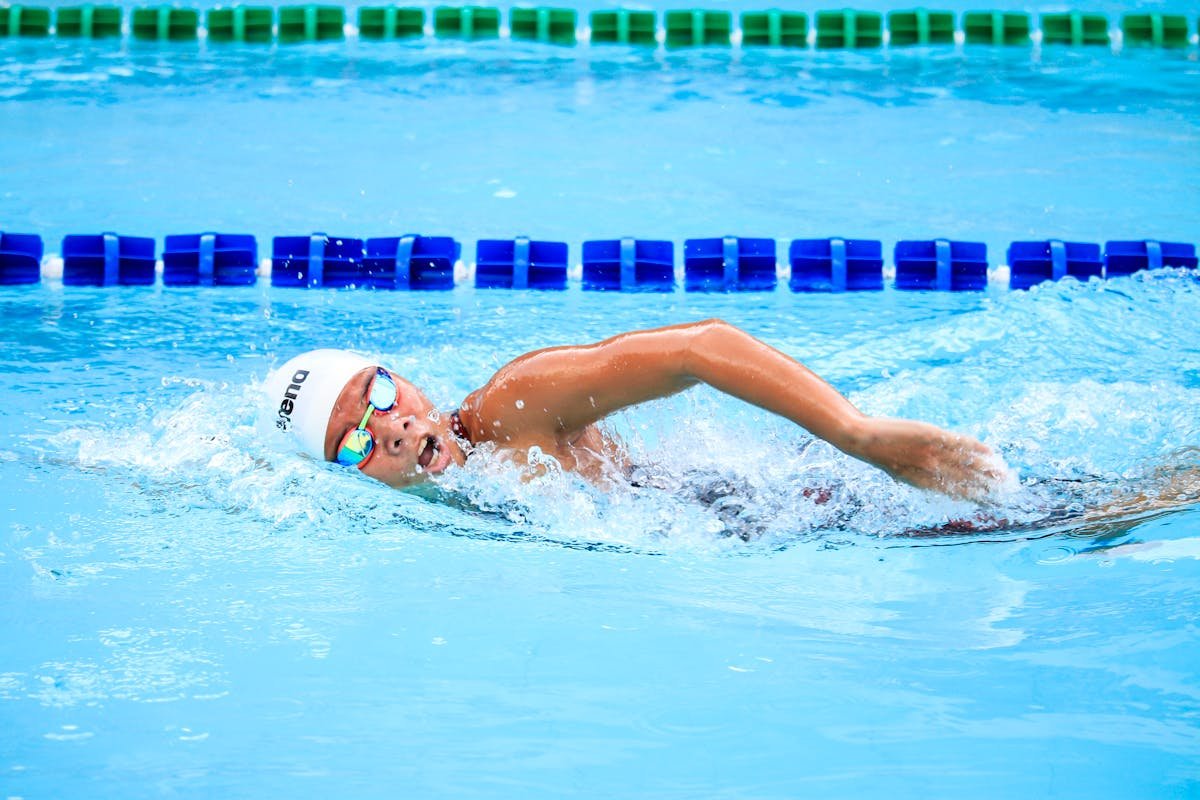Swimming for the disabled: learn all about the sport
Sport / Date: 04-13-2025

Swimming for the disabled, also known as adapted swimming, is a great alternative for therapy, recreation or even competitions. It works in a very similar way to conventional swimming, except for adaptations in preparation for entering the pool, and in the exits, arrivals and turns of participants, especially in tournaments and sporting events. In addition, there are specific guidelines and regulations for those who face visual complications and practice adapted swimming.
The benefits of this sport are felt in both the physical and mental health of the athlete, whether professional.
- increased self-esteem and self-confidence;
- development of body perception and sensitivity;
- improved motor coordination, resistance and flexibility; and
- achievement of independence and recognition of limits.
What is adapted swimming like?

Adapted swimming is a very complete sport and is very similar to conventional swimming, although it is practiced by athletes, amateurs and professionals who have some type of physical, visual or intellectual disability.
In addition to being able to move around in the water without needing a wheelchair, crutches, canes or prosthetics, and thus enjoying a very pleasant feeling of freedom that is positive for their physical and mental health, adapted swimming athletes also find the following advantages in this sport:
- relaxation of the spine, muscles and reduction of spasms;
- motor reeducation when necessary;
- improved balance;
- relief from muscle and/or joint pain;
- improved body posture and motor coordination;
- improved cardiac and respiratory resistance by strengthening the body's internal muscles;
- exploration and adaptation of limitations;
- anxiety control ;
- development of self-confidence and, in many cases, especially when athletes are intellectually disabled, development of socialization and spatial-temporal organization;
- improved motivation and mood;
- self-knowledge.
Many people call adapted swimming or swimming for the disabled Paralympic or Paralympic swimming and this name is not wrong.
This is because it gained fame with the Rome Olympic Games that took place in the 60s and has been used ever since, especially when it comes to sports competitions held in water and with athletes with some type of limitation or disability.
What is Paralympic swimming?
It is the same as adapted swimming, but you probably hear about it during events that gain prominence in the world press, such as the Olympics, and, therefore, associate this name with the practice of the sport directly aimed at competitions and not for therapeutic and recreational purposes.
What are the rules of Paralympic swimming?
- People with physical-motor disabilities, visual disabilities or intellectual disabilities can participate, distributed exactly in this way and according to the degree of impairment caused by their complications.
- Paralympic pools are identical to Olympic pools and have 8 competition lanes, 50 m long and 25 m wide.
- Adaptations to competitions occur at the start, finish and also during the turns made by athletes when they reach the other side of the pool. Swimmers with visual impairments, for example, receive a kind of “touch” from the baton when they are approaching the edges and athletes with motor impairments can start the competition from within the pool when necessary.
- Athletes may also request the presence of someone outside the water capable of assisting at the start and finish of all races.
- The competitions are also divided by sex, containing male and female categories.
- Athletes in Paralympic competitions can compete in individual or relay events, ranging from 50 m to 400 m, and in the “S” ( freestyle or crawl , backstroke and butterfly); “SB” (breaststroke) or “SM” (Medley) modalities.
Competing in freestyle swimming gives the athlete the opportunity to choose whether to swim 50, 100, 200 or 400 m. The breaststroke, backstroke and butterfly categories only offer the possibility of competing in 50 or 100 m. For medley swimming, there are two alternatives: 150 or 200 m.
Another interesting fact is that there is always a number added to the name of the sport in which an athlete competes. This number can vary from 1 to 10 and is always followed by the letter S for “swimmer” and indicates the level of commitment of the entire group of athletes who will compete at the same time.
Lower numbers represent lower commitment and higher numbers consequently represent higher commitment.
One thing to note: Paralympic swimming relay teams, which are always made up of four people, need their athletes' commitment levels to add up to 34 points. Only then will they be able to compete as a group according to the official rules.
Differences between the rules of Paralympic swimming and conventional swimming
The rules of Paralympic swimming are exactly the same as those of conventional swimming, with specific exceptions to ensure that the needs of athletes are fully met and also in the case of swimming for the visually impaired.
Therefore, it is:
- the use of the same types of clothing and outfits is permitted;
- any modification to clothing is prohibited;
- The use of any mechanism that gives any type of advantage to the competitor is prohibited, including prosthetics not authorized by regulatory bodies.
The time control and the strict monitoring of competitors during the race are also the same as in conventional practice.
Learn about the specifications of adapted swimming
Being aware of the rules can be interesting even for those who do not intend to practice the sport at a professional level, because the more a person knows about the sport they have chosen to practice, even as a hobby, the greater their confidence in making it part of their daily lives and the greater their interest in it.
What to look for in a swimming class adapted for therapeutic or recreational purposes?
Thinking about inclusion, accessibility and all the benefits of swimming for people with disabilities, those who choose to learn about and try this sport should preferably look for a school or gym that can offer:
- adequate physical assessment ;
- individual and personalized lesson planning, with realistic goals;
- instructors who are properly trained to implement lesson planning, provide instructions and monitor the practitioner;
- fully accessible changing rooms and swimming pools;
- constant monitoring by the lifeguard team;
- pools where the water temperature is suitable to provide the benefits of the practice, especially to the muscles;
- flotation devices and other accessories and equipment that contribute to the evolution of the practice.
Check out, in the next and last topic of this content, some tips on exercises performed during adapted swimming classes and applied solely and exclusively by teachers who understand the subject and help students, including, to lose their fear of swimming .
Swimming Exercise Tips for the Physically Disabled
To begin with, students and instructors of swimming for the physically, intellectually and visually impaired must carry out the so-called “adaptation to the liquid environment”, that is, familiarizing the person practicing the sport with the pool, with its access and also with the main movements to be performed in the future.
Then, frequent exercises begin , usually in this order:
- training on entering and exiting the pool;
- displacements at different depths, in a vertical position;
- small dives (immersions) and breathing control;
- balance exercises;
- floating practices;
- jumps, if they are part of the lesson plan;
- and, finally, swimming and its improvement over time.
It is worth noting that all exercises need to be adapted to the needs, possibilities and limitations of the practitioner and that training can take place in small , medium or large pools .
The role of specialized professionals in adapted swimming
An essential aspect of successful adapted swimming programs is the involvement of specialized professionals, including physical therapists, occupational therapists, and adaptive physical education instructors. These experts work closely with swimming coaches to create safe, personalized training plans that match each athlete's specific needs. Their expertise helps to monitor physical progress, prevent injuries, and ensure that swimmers are performing movements correctly and effectively. Additionally, these professionals play a crucial role in boosting the emotional and psychological well-being of participants, especially those who are new to water activities or have experienced previous traumas related to mobility or sports.
Community and emotional benefits of adapted swimming
Beyond the physical and technical elements, adapted swimming often creates a strong sense of community among its practitioners. Group classes and training sessions provide an environment of mutual support, motivation, and shared goals. For many athletes, especially those with intellectual disabilities, swimming becomes a channel for emotional expression and social interaction. Participating in local or national events not only boosts confidence but also brings a sense of achievement and belonging. This social engagement can significantly reduce feelings of isolation and increase overall life satisfaction, making adapted swimming a powerful tool for holistic health and inclusion.
Follow Us
Newsletter
Subscribe to our newsletter to stay updated with our latest news and offers.
We respect your privacy.Trending










